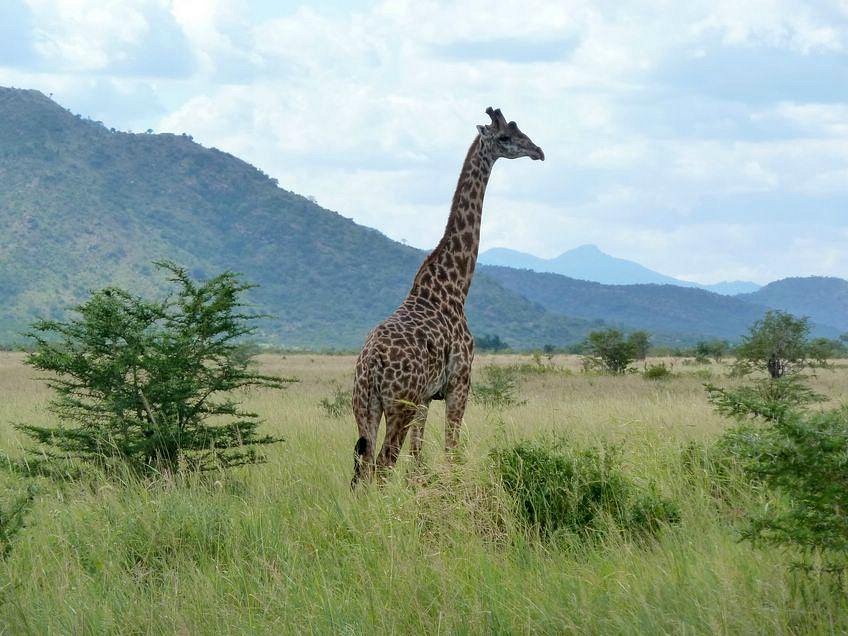Mkomazi National Park: A Comprehensive Guide
Mkomazi National Park is one of Tanzania’s lesser-known wildlife sanctuaries, located in the northeastern part of the country, bordering Kenya’s Tsavo West National Park. Covering approximately 3,245 square kilometers, Mkomazi was established as a game reserve in 1951 and upgraded to national park status in 2008. It forms part of the wider Tsavo ecosystem, and together with Tsavo West, it creates one of the largest and most important protected areas for wildlife in East Africa. The park’s name is derived from the Pare language, meaning “scoop of water,” a reference to the semi-arid landscape where water sources are scarce.

Mkomazi is renowned for its significant conservation efforts, particularly in the preservation of endangered species such as the black rhinoceros and the African wild dog. The park is home to the Mkomazi Rhino Sanctuary, a fenced-off area established to protect black rhinos from poaching. It is one of the few places in Tanzania where visitors can see these critically endangered animals. Mkomazi also plays an essential role in safeguarding African wild dogs, whose populations have suffered drastic declines across Africa.
Despite being less visited than more famous parks like Serengeti and Ngorongoro, Mkomazi offers a unique and secluded safari experience. The park’s landscape is a mix of arid savannah, acacia woodlands, and rocky hills, creating a stark yet beautiful wilderness that contrasts with the greener, more fertile areas of Tanzania.
Wildlife In Mkomazi National Park
Mkomazi National Park is home to a diverse array of wildlife, including several rare and endangered species. The park is particularly famous for its populations of black rhinos and African wild dogs, both of which have benefited from intensive conservation programs. The Mkomazi Rhino Sanctuary has been instrumental in breeding and protecting black rhinos, and while access to the sanctuary is restricted, visitors may be able to arrange special permits to observe these majestic animals under the supervision of park authorities.
In addition to rhinos and wild dogs, Mkomazi is home to many of the classic African savannah animals, including elephants, giraffes, zebras, and buffalo. Predators such as lions, leopards, and cheetahs are also present, though they can be more elusive due to the park’s vast and sparsely populated terrain. The open grasslands and acacia woodlands provide excellent habitats for these animals, and game drives offer ample opportunities to spot wildlife.
Herbivores such as hartebeests, impalas, and elands roam the plains, while dik-diks and other smaller mammals can be found in the park’s woodlands and scrubland. One of the unique aspects of Mkomazi is its population of lesser kudu, a shy and elusive antelope species that is rarely seen in other parks in Tanzania.
Birding In Mkomazi National Park
Mkomazi National Park is a paradise for birdwatchers, with over 450 species recorded within its boundaries. The park’s varied habitats, including savannah, woodland, and wetlands, attract a diverse range of bird species, from large raptors to small, colorful songbirds. The proximity to Tsavo and the semi-arid conditions make Mkomazi an excellent destination for those seeking to spot species that are less common in Tanzania’s more humid regions.
Bird enthusiasts can look forward to seeing species such as the kori bustard, the world’s heaviest flying bird, and the ostrich, Africa’s largest bird. Raptors are abundant in the park, with species like the martial eagle, bateleur eagle, and the tawny eagle often seen soaring above the plains in search of prey.
The park’s wetlands and water sources attract water birds like African fish eagles, kingfishers, and herons, while migratory birds, including various species of storks and swallows, can be observed during the wet season. Other notable birds include the violet wood-hoopoe, the white-headed buffalo-weaver, and the rosy-patched bush-shrike, adding vibrant colors to the otherwise arid landscape.
Vegetation In Mkomazi
Mkomazi’s vegetation is primarily characterized by semi-arid savannah, punctuated by acacia woodlands, grasslands, and rocky outcrops. The park’s vegetation reflects its dry climate, with hardy plant species adapted to the challenging conditions. The northern part of the park, bordering Tsavo, is more arid, while the southern section has slightly denser woodlands due to higher moisture levels from the Pare and Usambara Mountains, which lie nearby.
Acacia trees dominate the landscape, providing shade for animals and serving as an important food source for herbivores such as giraffes and elephants. These trees are interspersed with tall grasslands, which become green and lush after the rains but remain dry and golden for most of the year. Other common plants include baobabs, whose large trunks store water, and various species of thorny bushes and shrubs that are well-suited to the park’s dry conditions.
Along the seasonal rivers and watercourses, denser vegetation such as reeds and palms can be found. These areas provide critical resources for wildlife during the dry season when water is scarce. The diversity of vegetation types within the park supports a wide range of animal and bird species, creating an intricate ecosystem that thrives despite the arid environment.
Scenery
The scenery of Mkomazi National Park is rugged and breathtaking, offering visitors dramatic vistas and a sense of isolation that is hard to find in more popular parks. The park’s landscape is dominated by wide-open plains, rocky hills, and dramatic mountain ranges that create a striking contrast to the more lush parks of northern Tanzania. To the west, the Pare and Usambara Mountains form a picturesque backdrop, while to the north, the volcanic peaks of Mount Kilimanjaro and Mount Meru are visible on clear days.
The park’s open grasslands stretch out toward the horizon, dotted with acacia trees and the occasional baobab, creating an iconic African savannah scene. The rocky outcrops and granite kopjes that rise from the plains provide excellent vantage points for both wildlife and visitors, offering panoramic views of the park’s untamed wilderness.
Mkomazi’s rivers and waterholes, though seasonal, add to the park’s beauty, particularly during the wet season when they swell with water and attract large numbers of animals. These water sources are lifelines for wildlife during the dry season and often become gathering points for elephants, buffalo, and other animals seeking relief from the heat.
Activities and Main Attractions In Mkomazi National Park
Mkomazi National Park offers a variety of activities for visitors looking to explore its unique landscape and wildlife. The most popular activity is a traditional game drive, which takes visitors through the park’s vast savannahs and woodlands, offering opportunities to spot elephants, giraffes, and predators like lions and cheetahs. Game drives are especially rewarding in the early morning or late afternoon when animals are most active.
One of the main attractions in Mkomazi is the chance to see endangered black rhinos in the Mkomazi Rhino Sanctuary. While access to the sanctuary is restricted to protect the rhinos, visitors may be able to arrange special permits to observe these critically endangered animals in a secure environment. The sanctuary is part of a broader conservation effort aimed at increasing the population of black rhinos in Tanzania.
Another highlight of Mkomazi is the African wild dog, one of the continent’s most endangered carnivores. The park’s wild dog population is part of a successful reintroduction program, and seeing these rare animals in their natural habitat is a memorable experience.
Birdwatching is another key activity, with guided birding safaris available to explore the park’s diverse avifauna. Walking safaris, accompanied by experienced guides, allow visitors to learn about the park’s flora and fauna up close and gain a deeper understanding of the ecosystem. These walks are particularly rewarding for those interested in the smaller details of the park, such as tracks, insects, and plant life.
Best Time to Visit Mkomazi National Park
The best time to visit Mkomazi National Park depends on the type of experience you are seeking. For wildlife viewing, the dry season (June to October) is ideal, as animals are more concentrated around water sources and the vegetation is less dense, making it easier to spot wildlife. The dry season also offers more comfortable temperatures for game drives and walking safaris.
For birdwatchers, the wet season (November to April) is the best time to visit, as migratory birds flock to the park, and the landscape becomes more vibrant with the arrival of the rains. However, the wet season can make some roads impassable, and wildlife may be more dispersed, making it slightly more challenging to spot animals.
Weather and Climate
Mkomazi National Park has a semi-arid climate, with distinct wet and dry seasons. The wet season occurs from November to April, bringing much-needed rainfall to the park. During this period, the landscape transforms as the vegetation becomes lush and green, and water sources fill up. The wet season is also the best time for birdwatching, as migratory birds arrive in the park, and the rains bring an abundance of food for both resident and migratory species.
The dry season, which lasts from May to October, is characterized by hot, dry weather, with temperatures often reaching 30°C (86°F) or higher during the day. This period is ideal for wildlife viewing, as animals congregate around the remaining water sources, making them easier to spot. The dry season also offers clear skies and excellent visibility, with fewer chances of rain disrupting activities.
Park Rules In Mkomazi National Park
To ensure the protection of Mkomazi National Park and its wildlife, visitors must adhere to several important rules:
- Respect Wildlife: Maintain a safe distance from animals and avoid disturbing their natural behavior. Feeding or attempting to touch wildlife is strictly prohibited.
- Stay on Designated Roads: Off-road driving is not allowed, as it can damage the park’s fragile ecosystems
